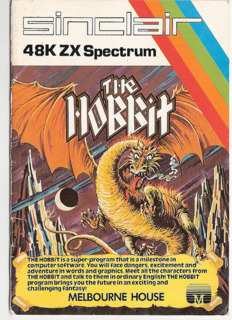Even with its obscure and short plot, The Hobbit is a true adventure game.
In fact, the first location, surprisingly, is a battlefield. But it’s merely a dream of Bilbo, who is beginning to experience the Tookish side of him, which wants to explore mountains, rivers, and valley, carry a sword instead of a walking stick, and so on. Most of the beginning of the game only gets you ready for what lays ahead. Hobbiton is the first chapter of the game, but all it possesses is mini-games and small treats and enhancements for the rest of the game. The silver pennies are what allow you to purchase items at level intervals, such as rock bag capacities, potions, and a few others. These pennies can be found all over the game, even though at the beginning, Bilbo claims that they spilled through a hole in his pocket. How were they dispersed all throughout the game? You be the judge. You can also pick up jewels, and when you gain a certain amount, your heart level is upgraded. Those that are familiar with Zelda’s trend should immediately fall in love with this game’s attributes. All through the game there are chests that contain all sorts of goodies, most of which contain money.
The character attributes are not only what makes The Hobbit similar to Zelda. The levels involve in depth puzzles and tasks that take time to complete. But instead of looking for keys to open doors, the levels really do fit well with the book, and only certain areas you can actually visit. A lot of areas are basic tasks; “Bilbo go this way or that way, and find this or that…” something along those lines. Saving your game requires a pedestal, which there are plenty of scattered throughout the game, which saves your spot right then and there. But once you save it, there’s no going back to previous levels ever again. Once you get the correct requirements, say a sword or arrow, and then it’s on to the next level. Some parts of the game actually have you sneaking past larger creatures that are out of you attack strength, and these situations are extremely pulse-pounding. And each level is named after a specific chapter in the book (though some are left out, for non-active reasons). No matter how you look at it, The Hobbit has an excellent Platforming basis that can get addictive.
There isn’t much to the control scheme. A is jump and B is sword attacks. You can, however, switch you attacks to throwing rocks or using a walking stick instead of a sword. The walking stick allows you to pull vault forward to more distant ledges. Over each course of the game you’ll get more and more upgraded, and the best one you could ask for, could be the One Ring. You find this Ring in Gollum’s Cave, where you win your way out thanks to a clever game of riddles. This Ring allows Bilbo to go invisible for a limited time. In the book, he could remain unseen for however long he wished, but that would be much too easy in the game. This trait goes back to the part where you sneak around certain perimeters to finish your mission. With the Ring on, Bilbo can freely, but his prescience can still be felt by an assortment of creatures, namely elves, which are in the game, and you must sneak around them. The combat alone is pretty straightforward and satisfying. Although you can easily slice through your enemies by swinging your sword frantically, the fighting can still get intense. Some levels have bosses at the end, some don’t. Others have pretty important fights in the middle of it all, and nothing at the end. Even with the lack of organization as far as enemies, the book was meant to be unexpected, and nothing can be too expectant in the game version.
Something else that’s greatly underappreciated is the game’s short story. Well, a good chunk of it you can’t actually play, because in the book it’s non-physical, while the other bit can only go so far. People don’t respect the fact that the game only follows the book, which is indeed limited for an adventure, but still satisfying at the same time. The cut scenes provide irrelevant entertainment, and the narration delves deeply into the book’s core, bringing out the best of its abilities. Though it may be short, the value is quite strong, and I often go back and replay it, just to see what I may have missed. Furthermore, there isn’t a lot to The Hobbit, but it’s still worth a shot for most casual gamers.

